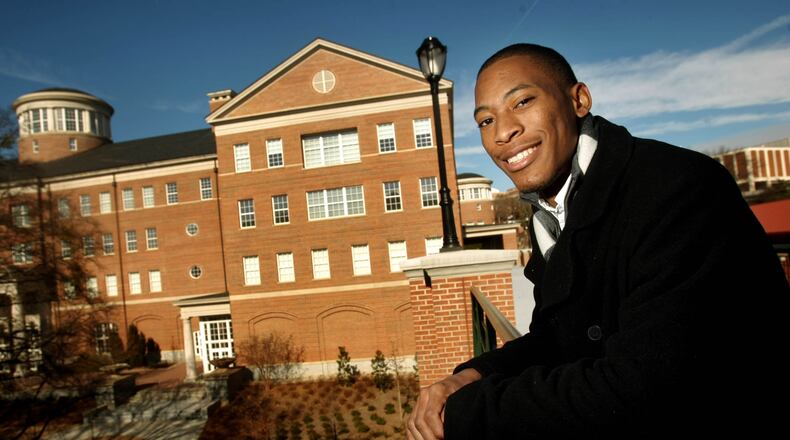Why are African-American students still underrepresented at the University of Georgia? How do we change that?
Two guest columnists tackle that question today. Before retiring, Jerry Arkin was the University of Georgia Griffin Campus administrator and a UGA professor. Jack Bernard, a retired corporate executive, was a two-term county commissioner and former county Republican Party chairman in Jasper County.
In talking to black students admitted to UGA but enrolled elsewhere, I’ve heard two frequent explanations for that decision. The first was UGA offered too little diversity. The second: The students chose private colleges that provided unique opportunities.
The AJC's higher ed writer Eric Stirgus delved into this issue in a great story last year.
With that, here is the guest column.
By Jerry Arkin and Jack Bernard
More than one-third of Georgia’s public school students are African-American, yet just one in 12 students at the University of Georgia is African-American, only 8.3 percent of the student population.
This startling statistic has not changed much in the last decade. Equally eye opening is the abysmal fact that since 1976, 43 years ago, this statistic has only increased from 3.6 percent.
Of the five largest public universities in Georgia, UGA has the second lowest proportion of African-American undergraduate students on campus, with only Georgia Tech lower at 6 percent, according to the University System of Georgia Fall 2017 Semester Enrollment Report.
Georgia State (41 percent), Georgia Southern (25 percent), and Kennesaw State (22 percent) are not just higher, they are much, much higher.
UGA integrated in 1961 under court order. Prior to that time, the state Legislature had passed a law cutting off funds to any “white” university admitting black students. Integration of UGA was not smooth and seamless.
UGA Office of Institutional Diversity efforts and programs to enhance undergraduate African-American enrollment have, by any objective measure, had limited success. Although black enrollment is increasing, it is increasing at a snail’s pace, with very marginal increases. Part of this may be due to increased competition/selectivity in admissions, but that isn’t the only factor.
UGA is well aware of the underrepresentation of undergraduate African-American students. Some of the initiatives put in place by UGA include:
-National Science Foundation, Louis Stokes Alliances for Minority Participation Program, a federally funded program designed to actively recruit, retain, and graduate under-represented minority students in STEM disciplines.
-The Georgia African-American Male Experience program was created to increase the enrollment and support of African American males at UGA. GAAME has a weekend program which focuses on leadership and leadership development. During this weekend, admitted students meet with distinguished faculty, prominent alumni, and leading members of the student body.
-Georgia Daze aims to encourage talented, historically underrepresented students to enroll at UGA. During this weekend, prospective students are exposed to classes, faculty, campus leaders, Housing, Student Affairs, special opportunities, dining halls, and the many extracurricular activities the campus has to offer.
-Other university efforts include recruitment events hosted by African-American alumni, a program that brings each public-school student from Clarke County on the campus every year, raising more money for scholarships for low-income students, and extending outreach to middle school students.
All of these initiatives are helping, but at what pace? Why is UGA still lagging behind most other University System of Georgia institutions of its size?
According to professor emeritus and retired Senior Associate Dean Ivery Clifton, the university’s College of Agricultural and Environmental Science implemented a successful model pipeline program that boosted African-American enrollment percentages within the college. The Young Scholars Program, once targeted exclusively at bringing high performing African-American high school students to work with research scientists, opened an opportunity to these students that engaged them in the pursuit of a college degree.
Pat Clifton, retired Young Scholars Program coordinator, believes that more than anything else, familiarity with a UGA campus, its faculty and staff helped these minority students make UGA a serious application contender for admittance. Perhaps, it is now time to expand the program or similar pipeline programs university-wide.
Like many other Young Scholars Program students, Aaron Trimble, now a graduate student at Texas A&M studying ecosystem science and management, attributes his choice of UGA for his undergraduate studies and his decision to pursue a career in research to his life-altering time as a Young Scholar.
"My Young Scholar Program experience was exceptional, as it cultivated me to be a young scientist capable of performing alongside my peers in the scientific community. The knowledge and confidence YSP gave me was the deciding factor in my choosing the University of Georgia for my undergraduate studies,” he said.
Overcoming the barriers of African-American undergraduate enrollment -- affordability, UGA racial history, access to opportunities, welcoming environment, etc. -- has to be a continuing UGA top-down priority for the pace of change to make a significant impact on enhancing African-American representation in the undergraduate student body.
Not succeeding is no longer an option.
About the Author
The Latest
Featured



